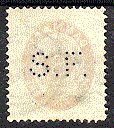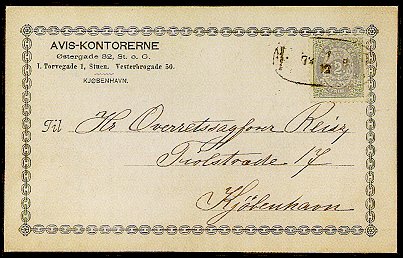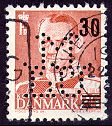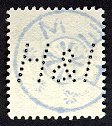![]()
| Introduction In the spring of 1996 I wrote a general article on this subject which was posted on the Internet STAMPS List and in the news groups rec.collecting.postal-history and rec.collecting.stamps. This article you see here only covers the Danish story on PERFINs. You can go back to the SPIFS/PERFINs Introduction Page by clicking here. Acknowledgements
What about PERFINs in Denmark? (The Danish text translated into English): |
 Perforation "inserted" by computer! |
Danish PERFINs The first firm mentioned - according to a hand-written note in the Danish Postal Museum in Copenhagen2 : "Firmaer, der benytter gjennemprikkede Frimærker" (Firms using punched stamps) - was Mr S Friedländer, a paper wholesaler who got permission to use a perforation mark "S.F." on 6 February 1876 (General Postmaster Circular No 4259). Although Friedländer got permission in 1876, the earliest recorded stamp with these initials dates from October 1892. A few days later, on 12 February 1876, permission was given to Grosserer S Seidelin to use "S.S.". This PERFIN is recorded from March 18763. |
| The Earliest Recorded Danish PERFIN Although the above-mentioned Danish PERFINs should be the earliest PERFINs, according to the files in our Postal museum in Copenhagen, we have one example of an earlier PERFIN. This PERFIN was discovered only a couple of years ago and is shown below4. This letter card is franked with a 2 Skilling from 1870 (9th printing) and sent locally in Copenhagen on 1 December 1874. The PERFIN is "C.F. & Co" which means C Ferslew & Co. from Store Kongensgade 24 in Copenhagen and owned by Jean Christian Ferslew. (3, PERFIN No C.17. 4, pp 84-85 and 5, pp 1 and 14-18)5. |
 |
 |
| The Postal Law from 4 December 1913 As mentioned, our GPO, in 1876, gave the first permission to a few firms to use PERFINs but no public announcements were made until the above-mentioned article appeared in "Tidsskrift for Postvæsen" in 1877. As late as 4 December 1913, our GPO made a regulation in which Section 31, Subsection d6, stated: "The General Postmaster can permit the use of postage stamps with special perforated marks". Notice that they did not limit these "special marks" to initials as they did at first in England. In the period 1876-1913 permission to use PERFINs was given administratively and our GPO found no reason to make this known to the public nor to publish it in their "Official Announcements from The Danish GPO" (called "OM" in Denmark). Further there was no announcements on PERFINs in the many small adjustments to the postal laws in the period 1876-1913. |
| The Exception Niels Klottrup described in 19827 that only one permission has been metioned in "OM": No. 46 from 12 May 1915, p 1488: II. Det meddeles herved Posthusene til fornøden Underretning, at der er meddelt Mejeriernes og Landbrugets Ulykkesforsikring, Reventlovsgade 14, Kjøbenhavn B, Tilladelse til indtil videre til Frigørelse af sammes Postforsendelser - herunder svarbreve, der tilstilles Ulykkesforsikringen fra andre Byer, og Postanvisninger, der for deres Regning fra andre Byer tilstilles dens Bankforbindelser i Kjøbenhavn - at anvende Postfrimærker, perforerede med Mærket "LMU". That was the "Dairy and Agricultural Insurance Company" who received permission to use a perforated mark in their stamps. The permission had GPD No. 5136 from March 1915. |
 this perfin is known from November 1920 to June 1976. The stamp is a 30-øre provisional stamp from 1956. Postmarked in Svendborg on Fyn. |
|
From the files at our Postal Museum we can see that 199 Danish firms, in the period from 1876 to 4 December 1913, asked for permission to use perforated stamps, but of these 199 firms, 36 are recorded as having used their perforated stamps before they actually received permission. In the same period, 102 other firms are recorded using "punched stamps" without any permission. PERFINs Became Decontrolled from 1 August 1917
Author's Remark |
 |
 Perforation "inserted" by computer! |
| A normal Handstamp and the "H&I" Perforator |
![]()
References:
|
![]()
Do you have additional information, please let me know:
Toke.Norby@Norbyhus.dk
Back to Toke Nørby's home page
Uploaded in 1998. Updated 2010.02.10